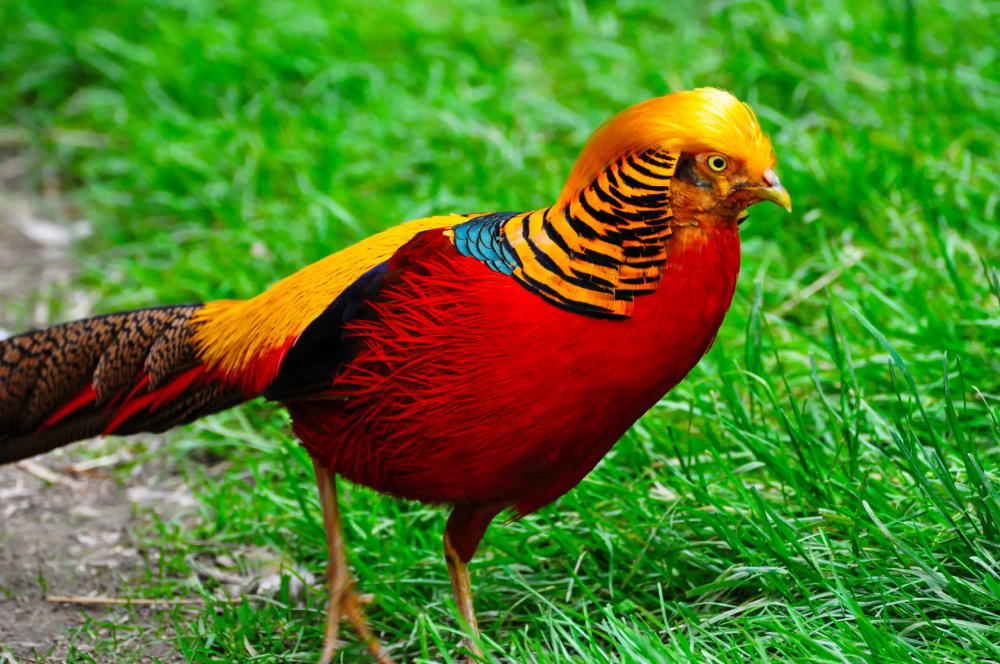Habitat and Distribution
Golden Pheasants are primarily found in the dense forests and mountainous regions of Western China. They favor coniferous forests and bamboo thickets, which provide ample cover and a rich source of food. Although their native range is limited, Golden Pheasants have been introduced to various parts of the world, including the United Kingdom, North America, and New Zealand, where they have adapted to local environments. These introduced populations often thrive in forested areas with a good underbrush layer that mimics their natural habitat.
Physical Characteristics
The Golden Pheasant is a medium-sized bird, with males reaching up to 90 to 105 cm (35 to 41 inches) in length, including their long tail feathers. Females are smaller, averaging around 60 to 80 cm (24 to 31 inches). The sexual dimorphism in this species is pronounced, with males displaying far more vibrant and elaborate plumage than females.
Male Golden Pheasant
The male Golden Pheasant is a spectacle of color. Its crest is a brilliant golden yellow, which extends over the head and down the nape. The face, throat, and chin are a rich scarlet, blending into a bright orange ruff that encircles the neck. This ruff can be raised during courtship displays to create an even more striking visual effect. The bird’s upper back is green, while the lower back is golden-yellow. The rump and the central tail feathers are a mix of cinnamon and buff, intricately barred with black. The breast and sides are a vibrant red, and the legs and feet are a pale yellow.
Female Golden Pheasant
In contrast, the female Golden Pheasant is much less conspicuous. Her plumage is primarily brown, mottled with darker shades, which provides excellent camouflage in the dense underbrush. This cryptic coloration is essential for protecting her from predators, especially when she is nesting or rearing young chicks.
Behavior and Diet
Golden Pheasants are primarily ground-dwelling birds, although they can fly short distances when necessary. They are known for their elusive and shy nature, often darting into thick cover at the slightest hint of danger. Despite this, they can become surprisingly tame and approachable in areas where they are protected from hunting and human disturbance.
Their diet in the wild consists mainly of grains, leaves, and invertebrates. They forage on the forest floor, scratching at the ground with their strong feet to uncover hidden food sources. In captivity, their diet is often supplemented with fruits, vegetables, and commercial game bird feed to ensure they receive all necessary nutrients.

Reproduction and Lifespan
Breeding season for Golden Pheasants typically occurs in the spring. Males engage in elaborate courtship displays to attract females, fanning their ruffs and tails while making a series of calls and movements. These displays are not only visually stunning but also play a crucial role in the mating process.
Once a pair has bonded, the female lays a clutch of 5 to 12 eggs in a shallow nest on the ground, usually hidden in dense vegetation. She incubates the eggs for about 22 to 23 days until they hatch. The chicks are precocial, meaning they are relatively mature and mobile shortly after hatching. They remain with the mother for several weeks, learning essential survival skills.
In captivity, Golden Pheasants can live up to 15 years, although their lifespan in the wild is typically shorter due to predation and other environmental factors.
Cultural Significance and Conservation
The Golden Pheasant holds a place of reverence in Chinese culture, often symbolizing beauty, good fortune, and prosperity. It is frequently depicted in Chinese art, literature, and folklore. In feng shui, the Golden Pheasant is considered a powerful symbol of happiness and success.
Despite their beauty and cultural importance, Golden Pheasants are not currently listed as endangered. However, their populations in the wild are declining due to habitat loss and hunting. Conservation efforts are focused on habitat preservation and creating protected areas where these birds can thrive without human interference.
Aviculture and the Golden Pheasant
The Golden Pheasant is a popular species in aviculture due to its striking appearance and relatively hardy nature. They are kept in aviaries and bird parks worldwide, often bred by enthusiasts who are captivated by their beauty. Proper care in captivity involves providing a spacious enclosure with plenty of natural cover, a varied diet, and protection from predators and harsh weather conditions.
Conclusion
The Golden Pheasant is a testament to the splendor of nature’s palette. With its vivid colors and intricate patterns, it captures the imagination of all who behold it. Beyond its aesthetic appeal, the Golden Pheasant serves as a symbol of cultural heritage and a reminder of the importance of conservation. As we continue to study and protect these magnificent birds, we ensure that their vibrant legacy endures for generations to come.









